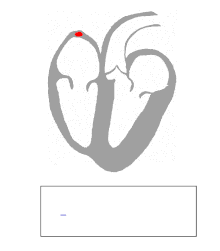User:Jonram27/Ventricular escape beat

A ventricular escape beat is a term used in cardiology to describe an automated electrical discharge and resulting contraction of the ventricles. The ventricular escape beat occurs when the rate of discharge from both the SA node and AV node falls below the basal rate determined by the ventricular pacemaker cells. [1] An escape beat usually occurs 2-3 seconds after the SA node has failed to initiate a beat, or the conductivity from the SA node is affected.[2]
This can be stimulated in response to Third degree AV block whereby atrial and ventricular contractions are completely imdependant. [3]
The escape beat forms a part of cardiac arrhythmia, in this case known as an ectopic beat. As a result of the escape beat, ventricular contraction rate is reduced to between 15-40 beats per minute. [4]
While the SA node typically initiates a rate of 70 beats per minute (BPM), the atrioventricular node (AV node) is usually only capable of generating a rhythm at 40-60 BPM.
If there are only one or two ectopic beats, they are considered escape beats. If this causes a semi-normal rhythm to arise it is considered an idioventricular rhythm.
The escape arrhythmia is a compensatory mechanism that indicates a serious underlying problem with the SA node or conduction system (commonly due to heart attack or medication side effect), and because of its low rate, it can cause a drop in blood pressure and syncope.
Diagnosis
[edit]An electrocardiogram can be used to identify a ventricular escape beat. The QRS portion of the electrocardiogram represents the ventricular depolarisation; in normal circumstances the QRS complex forms a sharp sudden peak. For a patient with a ventricular escape beat, the shape of the QRS complex is broader as the His bundle produces a slower heart rate [5]
The first 2.5 seconds show a normal cardiac cycle. This is followed by a period of delayed sinus activity which initiates a takeover response by the ventricular pacemaker cells resulting in a ventricular escape beat. Two escape beats are shown between 5-8 seconds.
See also: Junctional escape beat
Factors affecting ventricular escape rhythm
[edit]Cilostazol
[edit]Third degree AV block can be treated with Cilostazol which acts to increase Ventricular escape rate [6]
Ouabain
[edit]Ouabain infusion decreases ventricular escape time and increases ventricular escape rhythm. However, a high dose of Ouabain can lead to ventricular tachycardia[7]
References
[edit]- ^ C. Andreasen, et al (2006) Mosby Elsevier, Mosby's Dictionary of Medicine, Nursing and Health Professions 7th edition, p1951
- ^ V.S. Banka, B.J. Scherlag, R.H. Helfant (1975) Contractile and electrophysiological responses to progressive digitalis toxicity, Cardiovascular Research: 9, 65-72
- ^ D.D.Costa, W.J. Brady, J. Edhouse (March 2002), BMJ Publishing Group Ltd., ABC of clinical electrocardiography,British Medical Journal: 324:535-538.
- ^ D.D.Costa, W.J. Brady, J. Edhouse (March 2002), BMJ Publishing Group Ltd., ABC of clinical electrocardiography,British Medical Journal: 324:535-538.
- ^ M.G. Adams, M.M. Pelter (September 2003), Ventricular Escape Rhythms, American Journal of Critical Care, Volume 12 No.5
- ^ K.K. Takahashi, A. Kurata, K, Ohshima, K, Yamamoto, S. Uemura, S.Wantanabe, T. Iwaka (2003) American College of Chest Physicians, Effect of Cilostazol on Ventricular Escape Rateand Neurohumoural Factors in Patients with Third-Degree Atrioventricular Block, 123.41161
- ^ V.S. Banka, B.J. Scherlag, R.H. Helfant (1975) Contractile and electrophysiological responses to progressive digitalis toxicity, Cardiovascular Research: 9, 65-72
